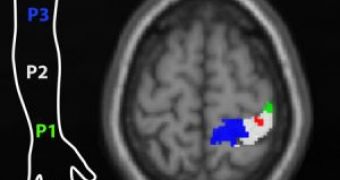What's the difference between a genuine sensation and an illusion? And why can such a thing as an illusion take place in the first place? Scientists have now studied what happens in the brain during a classical tactile illusion, the so-called cutaneous rabbit.
The illusion consists in the following: If a rapid succession of taps is delivered first to the wrist and then to the elbow, one also feels another tap between them - although no tap has been actually delivered in the intermediary position. The illusion is called the "cutaneous rabbit" because it feels like a rabbit hopping on one's arm.
Felix Blankenburg, Jon Driver, and their colleagues set to investigate which brain regions play a role in illusory tactile perceptions. In order to do this they used the functional magnetic resonance imaging (fMRI) technique to scan the brains of people experiencing the illusion compared to people that actually received taps. They have discovered that the same brain region is activated both when the tactile sensation is illusory and when it's real.
The researchers applied three equidistant electrodes on the inner side of participants' left forearms, starting from just above the wrist toward the elbow. The electrical stimulation delivered the taps while the participants were inside the scanner. Some participants received three pulses in succession, while others received only on the first and third points. The timing of the two pulses also created the illusion that the intermediary point had been stimulated.
The scientists looked for the brain regions that manifested increased activity and looked for the differences and the resemblances between the brain activities of the people who had the illusion and those who experienced the actual three-tap "rabbit" walk.
There was only one area of the brain that increased in activity - the area where the tactile signals from the middle on the forearm are sent. The fact that this brain region really corresponds to that place on the forearm had been determined by a previous mapping of the representation of the skin sites in each participant's brain.
Scientists found no difference in terms of brain activity between the illusion and the real thing. In other words, the illusion happens because, for the brain, the two situations are identical. The illusion is differentiated from the real thing only by the external observer who knows that the participant is placed in two different conditions. This provides further support for the materialist view that the mind and the spiritual experiences such as sensations are not separated from the brain, but are in fact functions of the brain. The reason why someone has the same sensation (thus a spiritual experience) in two different external conditions is that its brain does the same thing in both situations.
Picture credit: Blankenburg et al.

 14 DAY TRIAL //
14 DAY TRIAL //